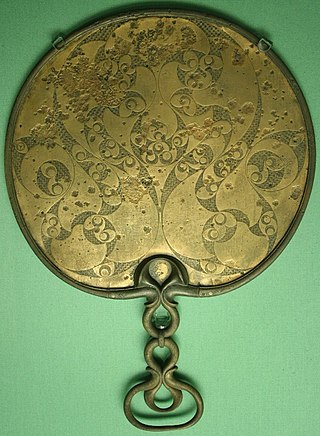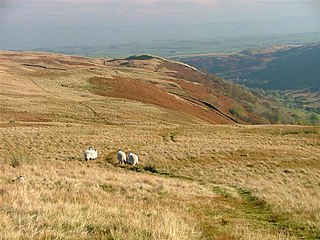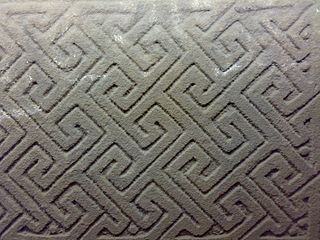
In Greek mythology, the Labyrinth was an elaborate, confusing structure designed and built by the legendary artificer Daedalus for King Minos of Crete at Knossos. Its function was to hold the Minotaur, the monster eventually killed by the hero Theseus. Daedalus had so cunningly made the Labyrinth that he could barely escape it after he built it.

A maze is a path or collection of paths, typically from an entrance to a goal. The word is used to refer both to branching tour puzzles through which the solver must find a route, and to simpler non-branching ("unicursal") patterns that lead unambiguously through a convoluted layout to a goal. The term "labyrinth" is generally synonymous with "maze", but can also connote specifically a unicursal pattern. The pathways and walls in a maze are typically fixed, but puzzles in which the walls and paths can change during the game are also categorised as mazes or tour puzzles.

In mathematics, a spiral is a curve which emanates from a point, moving farther away as it revolves around the point. It is a subtype of whorled patterns, a broad group that also includes concentric objects.

Glastonbury Tor is a tor near Glastonbury in the English county of Somerset, topped by the roofless St Michael's Tower, a Grade I listed building. The site is managed by the National Trust and has been designated a scheduled monument. The Tor is mentioned in Celtic mythology, particularly in myths linked to King Arthur, and has several other enduring mythological and spiritual associations.

Maze generation algorithms are automated methods for the creation of mazes.
Adrian Fisher is a British pioneer, inventor, designer and creator of mazes, puzzles, public art, tessellations, tilings, patterns and networks of many kinds. He is responsible for more than 700 mazes in 42 countries since 1979.

A whorl is a single, complete 360° revolution or turn in the spiral or whorled growth of a mollusc shell. A spiral configuration of the shell is found in numerous gastropods, but it is also found in shelled cephalopods including Nautilus, Spirula and the large extinct subclass of cephalopods known as the ammonites.

Celtic art is associated with the peoples known as Celts; those who spoke the Celtic languages in Europe from pre-history through to the modern period, as well as the art of ancient peoples whose language is uncertain, but have cultural and stylistic similarities with speakers of Celtic languages.

Historically, a turf maze is a labyrinth made by cutting a convoluted path into a level area of short grass, turf or lawn. Some had names such as Mizmaze, Troy Town, The Walls of Troy, Julian's Bower, or Shepherd's Race. This is the type of maze referred to by William Shakespeare in A Midsummer Night's Dream when Titania says:

Mizmaze is the name given to two of England's eight surviving historic turf mazes, and also to a third, presumably once similar site that is now merely a relic. Of the two which survive, one is at Breamore, in Hampshire; the other is on top of St Catherine's Hill, overlooking the city of Winchester, Hampshire.

Many turf mazes in England were named Troy Town, Troy-town or variations on that theme presumably because, in popular legend, the walls of the city of Troy were constructed in such a confusing and complex way that any enemy who entered them would be unable to find his way out. Welsh hilltop turf mazes were called "Caerdroia", which can be translated as "City of Troy".

Perplexus is a 3-D ball-in-a-maze puzzle or labyrinth game enclosed in a transparent plastic sphere. By twisting and turning it, players try to maneuver a small steel ball through a complex maze along narrow plastic tracks. The maze has many steps. The number of steps ranges from 30 in the Perplexus Twist to 225 in the Perplexus 3x3 Rubik's cube Hybrid. Some levels drop the ball into a cup or a small rim to utilize its 3-D nature. Players must complete obstacles varying in difficulty to reach the end.

The Blythe Intaglios or Blythe Geoglyphs are a group of gigantic figures incised on the ground near Blythe, California, in the Colorado Desert. The ground drawings or geoglyphs were created by humans for an, as yet, unknown reason.

Corpse roads provided a practical means for transporting corpses, often from remote communities, to cemeteries that had burial rights, such as parish churches and chapels of ease. In Britain, such routes can also be known by a number of other names, e.g.: bier road, burial road, coffin line, coffin road, corpse way, funeral road, lych way, lyke way, or procession way. etc. Such "church-ways" have developed a great deal of associated folklore regarding ghosts, spirits, wraiths, etc.

Trinity Square is a public square in downtown Toronto, Ontario, Canada. It is bounded on the east by the Toronto Eaton Centre, on the south and west by the Bell Trinity Square office complex, and on the north by the Marriott Downtown Eaton Centre hotel.

The Lusus Troiae, also as Ludus Troiae and ludicrum Troiae was an equestrian event held in ancient Rome. It was among the ludi ("games"), celebrated at imperial funerals, temple foundings, or in honor of a military victory. The lusus was occasionally presented at the Saecular Games, but was not attached regularly to a particular religious festival.

A Roman mosaic is a mosaic made during the Roman period, throughout the Roman Republic and later Empire. Mosaics were used in a variety of private and public buildings, on both floors and walls, though they competed with cheaper frescos for the latter. They were highly influenced by earlier and contemporary Hellenistic Greek mosaics, and often included famous figures from history and mythology, such as Alexander the Great in the Alexander Mosaic.
Aidan Meehan is an Irish artist and author of 18 books on Celtic art and design. including the eight-volume Celtic Design series and Celtic Alphabets, Celtic Borders, The Book of Kells Painting Book, The Lindisfarne Painting Book and Celtic Knots, all published by Thames & Hudson

Key pattern is the generic term for an interlocking geometric motif made from straight lines or bars that intersect to form rectilinear spiral shapes. According to Allen and Anderson, the negative space between the lines or bars of a key pattern “resemb[es] the L- or T-shaped slots in an ordinary key to allow it to pass the wards of the lock.”


















